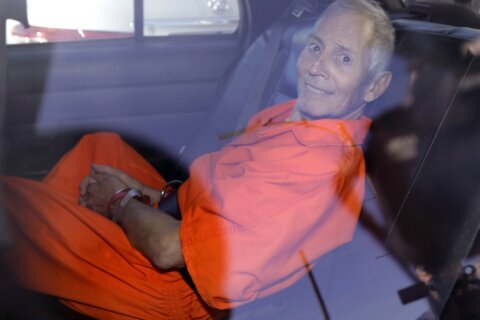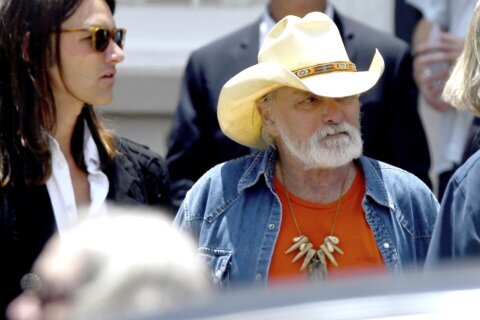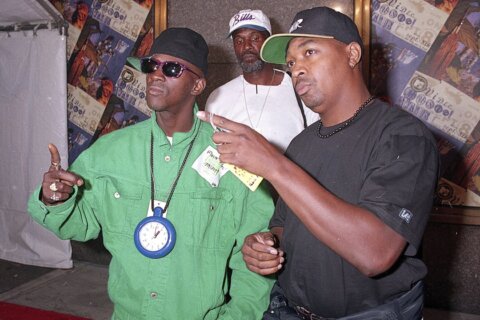WASHINGTON — A talented teen pulls her bow across a special set of strings.
Standing poolside at the Oscar Nominees Luncheon on Feb. 6, Denzel Washington stops in his tracks to listen to the soulful violin of 14-year-old Brianna Perez, whose touching story is chronicled in the Oscar-nominated documentary short “Joe’s Violin,” directed by Bethesda native Kahane Cooperman.
“It was an incredible moment I will probably never forget,” Cooperman told WTOP. “[Denzel] asked if she wanted a photo. She said, ‘Yes,’ and he said, ‘OK, on one condition: Play something for me.’ So, right then and there, by this pool in front of strangers and Denzel Washington, her idol, Brianna pulled out Joe’s violin … and played Pachelbel’s ‘Canon in D’ for him. … Despite the fact that it was on such a busy day, he took time for her … I’m surprised you can’t hear me sniffling in the background.”
It was a goosebump moment in a whirlwind Oscar ride for Cooperman, who graduated from Walt Whitman High in Bethesda before moving to New Jersey. After earning 11 Emmys and 2 Peabodys producing “The Daily Show with Jon Stewart,” this marks her first ever Academy Award nomination.
“I had my daughter and my husband in the room with us while we watched the announcement on television — my son had already gone off to school,” Cooperman said. “We sat on the edge of the couch in our living room and heard the announcement. Of course, when we heard the name of our film, we just screamed and teared up and every clichéd reaction that you think you won’t do, you do.”
The film follows 91-year-old Holocaust survivor Joseph Feingold, who was living on the Upper West Side of New York City when he heard about a charity instrument drive by WQXR Radio and the Mr. Holland’s Opus Foundation. He donated his precious violin, which wound up in the hands of 12-year-old Perez, a Dominican-American girl living in America’s poorest congressional district in the Bronx.
“Two strangers from completely different walks of life, born 80 years apart [are] connected by a single violin,” Cooperman said. “I didn’t know if the violin had a significant history when I started doing this, but in talking to Joseph, I soon found it had an incredibly poignant history attached to it.”
Born in Warsaw, Poland, in 1923, Feingold grew up in a musical family and learned to play violin with his mother until the Nazis and Soviets invaded Poland. At age 17, Feingold was sent to a Siberian labor camp for over six years, while his mother and brother were killed in concentration camps. After the war, Feingold fled with his father to Germany and eventually resettled in New York, where he found work as an architect and traded a pack of cigarettes for a violin to play in memory of his family.
“Once I learned the story from Joseph and felt like he was a wonderful storyteller, I thought I’d follow and see what happened,” Cooperman said. “[The violin] couldn’t have gone to a more impressive school, and they chose a really unusual and amazing young 12-year-old girl to receive the violin.”
Born to Dominican parents, Perez is one of many students at the Bronx Global Learning Institute for Girls that comes from new immigrant families, mostly from South America, the Caribbean and Africa.
“Brianna’s family is from the Dominican Republic [and] Joseph came here as a refugee,” Cooperman said. “Both he and Brianna are classic immigrant stories and these beautiful people that make up the fabric of what makes our country what it is.”
Like any great filmmaker, her adherence to theme allowed her to capture happy accidents on camera.
“There’s a moment toward the end when Brianna and Joseph say goodbye and Joseph gets into a car,” Cooperman said. “The Uber drives away with Joseph, this immigrant and refugee, leaving a school where this young girl is. This car we just happened to get, happens to have an American flag waving in the wind as it drives away. That has taken on, since the election, an incredible resonance for me.”
Not only does the film exude such Statue of Liberty ideals, it also speaks to the generous spirit of the American people. The instrument drive initially estimated it would receive 1,000 instruments, but it received a whopping 500 donations on the first day alone and a total of 3,000 instruments by the end.
“This film is about many things and one of them is about how a small act can have a truly great impact,” Cooperman said. “You have to imagine that every single one of those instruments has a story and all of these instruments are being connected with kids who I’m sure also have amazing stories.”
You can tell Perez appreciates the deep history of Feingold’s violin. At one point, she tells her classmates, “There are so many secrets in this violin.” Later she says, “I have history in my hands.”
That history is conveyed using black-and-white photos, showing how Feingold wrote his mother letters once a month from his labor camp. One day, she writes him back with chilling lyrics.
“She wrote him back a particularly poignant letter that quoted the lyrics of “Solveig’s Song” written by Edvard Grieg,” Cooperman said. “It was a passage from the song about someone who’s missing someone and will wait for them and will be there when they return. … There’s added poignancy to the fact that when Joseph received this letter, he did not know that he would never see his mother again.”
So you can imagine the emotion in the room when Joseph first meets Brianna, who pulls out the violin and plays that very song for him. Pulling the bow across those strings, it’s as if Joseph’s mother is standing in the room with them, fulfilling her promise that she will wait for him on the other side.
“I couldn’t have predicted she would invite him to the school and that he would accept,” Cooperman said. “I also didn’t know if they’d actually connect, but the connection in the moment of meeting is so tangible and palpable, you could feel it when we were filming it and I think it comes across in the film. It’s a true bond. They are forever bonded and they stay in touch to this day. They love each other.”
No doubt, Feingold and Perez will also keep in touch with Cooperman, who just captured their story with such blinding humanity. Its a rare gift that should bring pride to Bethesda and her peers back at Walt Whitman High (“Go Vikings!”). How did Cooperman make her way into such vital filmmaking?
“I went to college in Chicago after Whitman and I started working in theatre there,” Cooperman said. “I was also always watching a ton of films and I started applying everything I was learning in theatre to films. … Then I ended up just taking off with that and went to graduate school in New York City to film school at Columbia [University] and I ended up just really falling in love with the documentary storytelling form and telling real people’s stories. Nothing moves me or interests me more than that.”
Soon, she began working for veteran documentary filmmakers Albert & David Maysles, famous for such legendary docs as “Salesman” (1969), “Gimme Shelter” (1970) and “Grey Gardens” (1975). Who knew that this doc work would open doors of opportunity to the biggest television job of her career?
“It was because of my documentary background that I got hired as a field producer on a new show called ‘The Daily Show’ in 1996,” Cooperman said. “No one knew anything about it. The host was not Jon Stewart yet, it was a guy named Craig Kilborn. I was hired as a field producer to essentially create these 3-4 minute news-like pieces with correspondents. … Little did I know that those 12 weeks would turn into more than 18 years of an amazing job where I ended up being co-executive producer.”
Not only did the show win dozens of awards, it set the daily tone for American comedy and politics.
“It really is a comedy show … but I do think people felt strongly about what we were commenting on, so there was a lot of inherent passion throughout the entire staff,” Cooperman said. “Coming from the top, Jon Stewart cared deeply about everything we made hay of during the show. I do think that rang true for people and I think that was one of the reasons the show was the success that it was.”
Despite the show’s success, Cooperman never lost sight of her true passion.
“I never lost my passion for documentary storytelling,” she said. “I was hungry to keep doing it. I was able to make one film during my time there, and then years later, I really felt strongly that I needed to make another one, so I started making ‘Joe’s Violin’ on the side while I worked on ‘The Daily Show.'”
That’s right, while Stewart was directing his own side project “Rosewater” (2014), Cooperman was putting the finishing touches on “Joe’s Violin,” which premiered at the Tribeca Film Festival. It’s only fitting that Cooperman left ‘The Daily Show’ just months before Stewart retired from the show.
“I truly appreciate that it was Jon Stewart who led that show,” she said. “He was very supportive of myself and anyone who had side projects that they felt passionate about. He thought that was really important for you to be able to do, so as long as you did your job, you would always get the blessing to pursue your passions, which doesn’t always happen, so I will be forever appreciative of that.”
Listen to our full conversation with “Joe’s Violin” director Kahane Cooperman in the audio below, then watch the entire 24-minute Oscar-nominated documentary in the video below:








